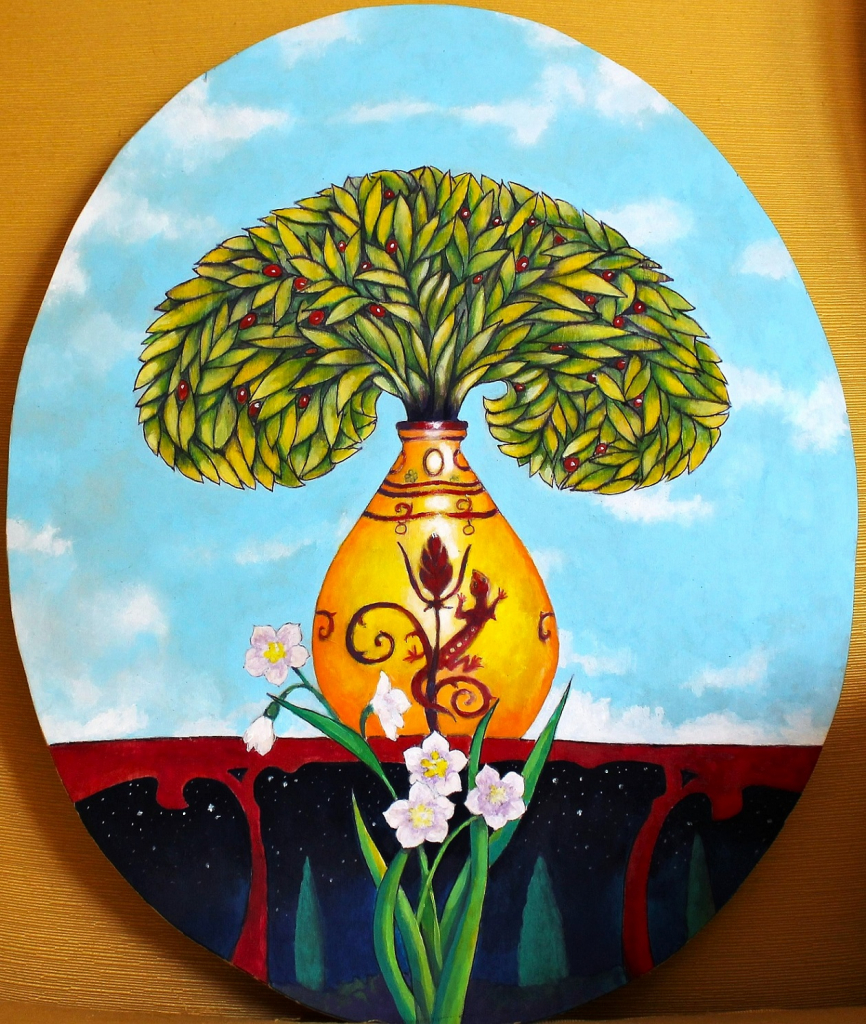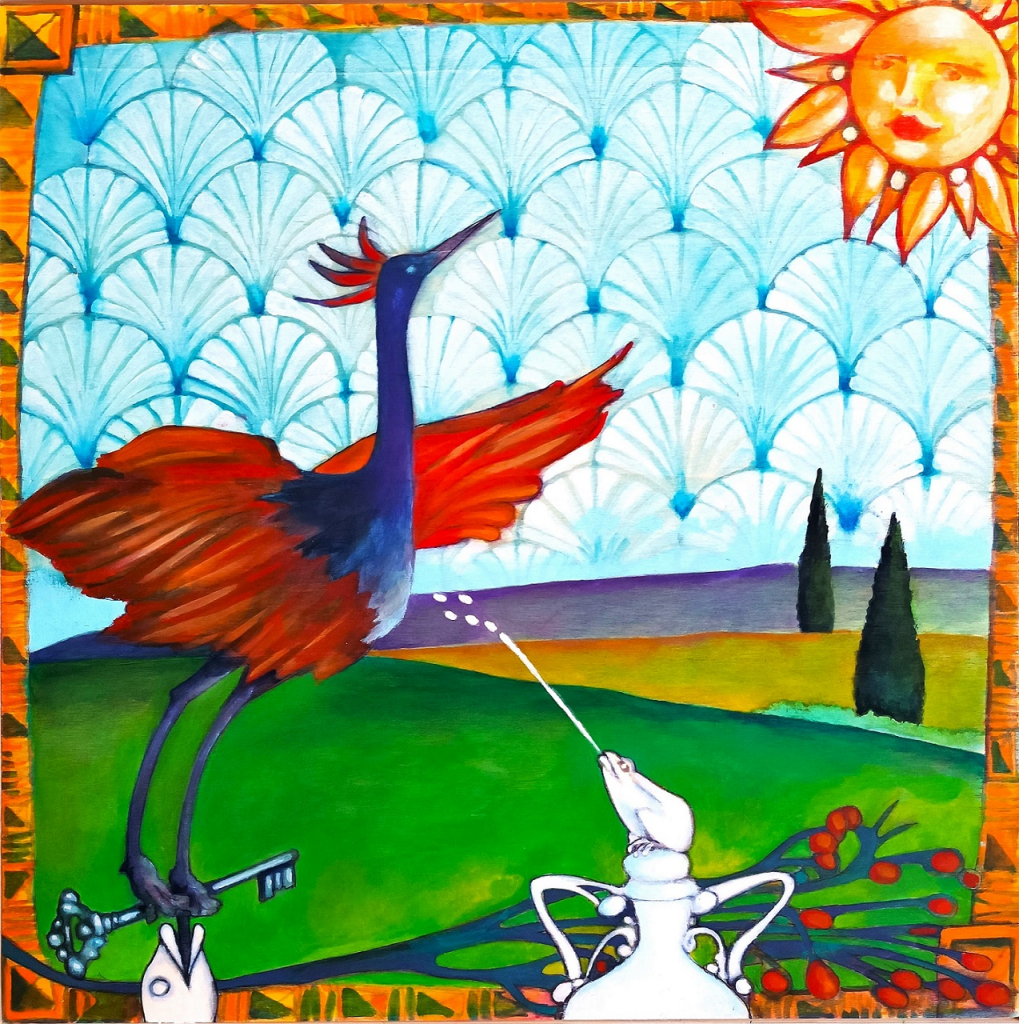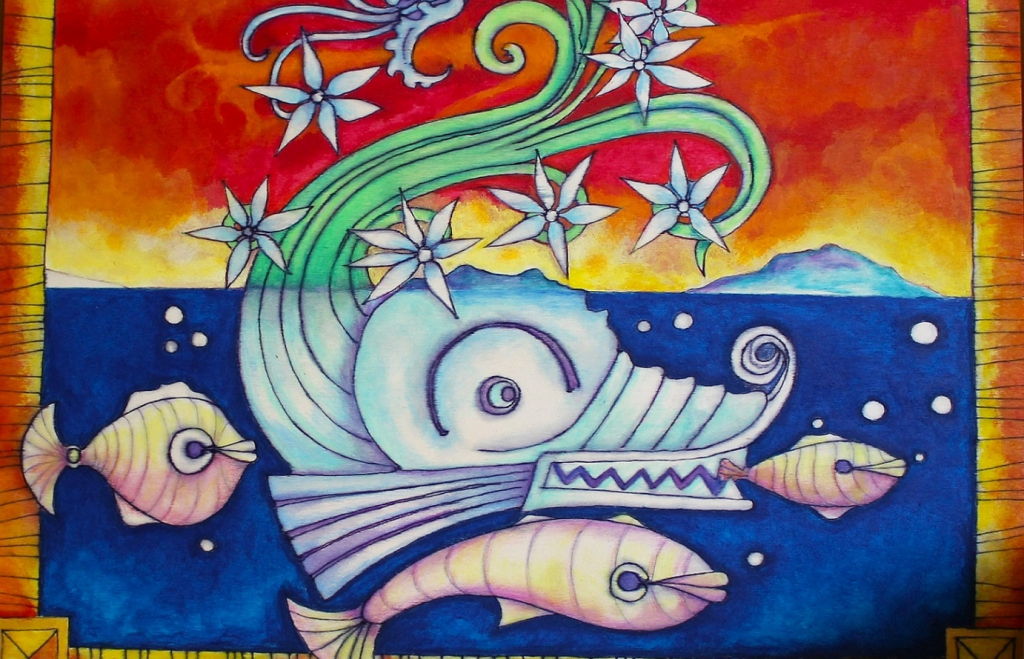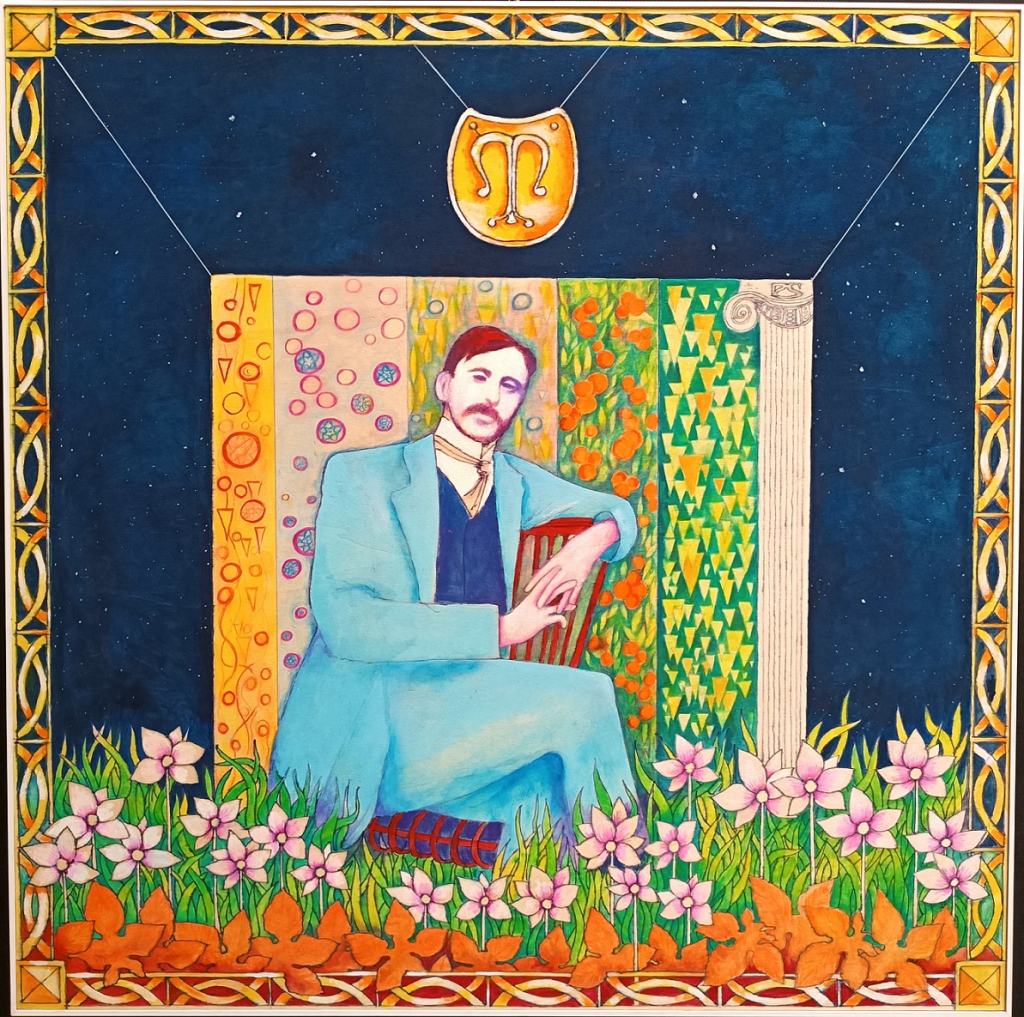di Marta Lock

La professione di architetto lo ha condotto non solo a sperimentare la duttilità di molti materiali ma anche ad avere un approccio aperto nei confronti della manifestazione artistica che, di fatto, può non limitarsi all’utilizzo della tela; e così Paolo Solei parte proprio dal legno per realizzare le sue coinvolgenti tavole che raccontano di un mondo Naif ma al tempo stesso stiloso, molto vicino alle decorazioni dello stile artistico di fine Ottocento, il Liberty, lei cui linee guida erano orientate a esaltare la piacevolezza e la bellezza ma anche, e soprattutto, la sinergia tra le varie forme d’arte e le produzioni artigianali che a quel punto divenivano a loro volta opere d’arte. Paolo Solei da questo punto di vista è sempre stato erede di questo concetto, di questo approccio trasversale all’espressione creativa che lo induce a misurarsi con vari materiali, con vari oggetti più vicini all’artigianato senza mai dimenticare un’impronta personale e unica. Usa il disegno, l’illustrazione, la pittura, ispirandosi spesso alla sua regione, la Toscana, ma anche ai tanti paesi che ha visitato viaggiando, da cui ha imparato ad amare e a lasciarsi conquistare dalle profonde diversità che costituiscono l’unico mezzo per l’essere umano di crescere, confrontarsi e di mantenere un atteggiamento aperto e inclusivo. E così nelle sue opere descrive paesaggi immaginari e sognanti che potrebbero anche essere una mescolanza tra tutti quelli che ha conosciuto, come se nella memoria emotiva non esistessero confini bensì uno scrigno interiore da aprire lasciando fluire i ricordi a volte sovrapposti. La sua dinamicità creativa lo spinge anche a realizzare oggetti da arredamento in legno colorato, trasformando vecchie cose che vivono così di nuova vita; tanto quanto l’incontro con la ceramica gli ha permesso di produrre la serie di vasi con tappi eclettici, sempre affini al suo singolare sguardo sulla realtà. Ma la sua attitudine alla poliedricità non si ferma qui, è anche decoratore di interni, in particolar modo gli viene richiesto di adornare le stanze dei bambini che del suo stile riescono a cogliere la magia e l’immediatezza dove racconta di un mondo semplice, rasserenante perché in fondo il suo, e quello dei bambini, è il modo migliore di osservare e vivere la realtà. I suoi soli, i gatti, i pesci, la natura, i dirigibili, gli aquiloni che fanno parte delle sue opere pittoriche su tavola, in cui mescola incisioni, punte secche, serigrafia, acquarello, sembrano invitare l’osservatore ad abbandonare le ombre e le complessità della contemporaneità per scegliere un mondo singolare, divertente, forse strano ma decisamente piacevole in cui l’artista mostra attraverso l’arte un’altra possibilità. Recentemente si è dedicato a un progetto specifico su richiesta del Comune di Montecatini Terme in cui gli era stato richiesto di raccontare in modo contemporaneo lo Stile Liberty, che contraddistingue la cittadina grazie ai lavori del maestro toscano Galileo Chini, e che è affine alle sue corde espressive.

Il risultato è stato un grande successo, la sala esposizioni dell’affascinante complesso termale Tamerici si è riempita dei colori accesi e vivaci di Solei, dei suoi personaggi del mondo animale e naturale che sembrano guardare il mondo di qua, quello dell’osservatore, come qualcosa di strano perché troppo lontano dalla loro spontaneità; e il pubblico ha compreso, apprezzato, visitato, si è lasciato condurre per mano in un mondo irreale quanto bizzarro senza sentirsene allontanato a causa della sua distanza dalla realtà oggettiva, piuttosto se ne sentito ammaliato perché consapevole di trovarsi davanti a una dimensione fiabesca che alla fine dispiace lasciare.

Rana
La connessione dello stile pittorico di Paolo Solei con il Liberty è perfetta, totale, sembra quasi un’interazione che oltrepassa il tempo e riattualizza linee guida e tematiche di base per assecondarle alla contemporaneità, a un periodo storico in cui l’essere umano ha bisogno di ritrovare la gioia di vivere; così le tonalità accese e vivaci divengono un invito a ricordare che c’è sempre una possibilità, c’è sempre un altro punto di vista in grado di cambiare l’approccio verso il mondo. Andiamo ora ad approfondire la conoscenza di questo poliedrico artista e a scoprire di più sui suoi progetti.
Paolo, il suo stile è originale e coinvolgente, quali sono state le sue fonti di ispirazione per dar vita a qualcosa di tanto nuovo e inedito? E perché la predilezione del legno rispetto alla tela come base pittorica?
Ho disegnato, dipinto e creato potrei dire da sempre, con continuità. Non voglio dire con questo che ho realizzato opere d’arte da quando ero bambino, naturalmente. Dico che il disegno, il plasmare e utilizzare vari materiali e soprattutto il colore sono stati e sono i compagni della mia vita. Per questo sono stato attirato dal mondo dell’arte e dai sui protagonisti da subito. Principalmente mi affascia il figurativo perché dalle forme e dal colore nascono storie, situazioni, incontri emozionanti. Le pitture di epoca romana, l’essenzialità delle opere medievali, le suggestioni di Piero della Francesca, e via via fino al racconto figurativo, con particolare riferimento al Simbolismo e all’Espressionismo mi hanno progressivamente, direi lavorato dentro. Ma come non pensare ai simboli e alle storie dell’arte egizia e precolombiana. Ecco, tutto questo sovrapporsi, sedimentarsi mi ha portato a esprimermi come le mie opere raccontano. Certamente difendendo il più possibile quella propensione infantile a usare strumenti, materia e colore per stare bene. È vero, nel corso degli anni ho concentrato la mia produzione nell’utilizzo del legno, di tavole non trattate. Il legno assorbe e mi guida anche nella creazione dandomi spunti e suggerimenti nella modalità di utilizzo del colore. Molto spesso certi effetti, certe strade che il colore prende a contatto con il legno sono inaspettati e mi piace assecondarli.

Parliamo ora del progetto Liberamente Liberty. Ci racconta come è nata l’idea e quanto è stato stimolante per lei creare le bellissime opere ispirate dalle tematiche di uno stile che ha letteralmente conquistato l’Europa?
Sinceramente quel periodo storico mi ha sempre affascinato perché fondamentalmente il disegno per me è fondamentale e nelle opere classificabili come Art déco, Art nouveau, Liberty, Secessione viennese, il nome dipende dal paese di provenienza degli artisti, nell’esperienza del Bauhaus, è davvero fondamentale. Diciamo che il fermento e l’innovazione che hanno caratterizzato il periodo a cavallo tra il IX° e il XX° secolo sono stati eccezionale in termini di innovazione. Soprattutto mi interessa tantissimo l’intreccio tra arte, grafica, artigianato, design. Devo dire che il fascino che sprigionano le opere del periodo è fortissimo ancora oggi. Io semplifico parlando spesso di Liberty ma le sfaccettature son tantissime e tutte potenti e stimolanti. Poi la vita mi ha portato a vivere oggi a Montecatini e a godere tutti i giorni dei capolavori del maestro Galileo Chini. Così ho preso a liberare la mia creatività emozionato dal Liberty che in quella città è ovunque.
Il grande successo e l’approfondimento che ha compiuto durante il periodo di realizzazione delle tavole, ha avuto modo di scoprire che il 2023 ricorreranno i 150 anni dalla nascita del grande maestro dello Stile Liberty italiano, Galileo Chini. Pensa che possa essere possibile sviluppare l’idea e trasformare Liberamente Liberty in un progetto itinerante e replicabile in varie città italiane? Alla luce di questo, amplierà la produzione di opere ispirandosi anche ai suoi dipinti, molto vicini per tecnica pittorica e per l’ampio uso della foglia oro a quelli di Gustav Klimt?
L’opportunità che il Comune di Montecatini mi ha offerto, quella di realizzare una mia personale nel salone delle mostre del compendio termale Tamerici, l’ho colta al volo. Non posso descrivere l’emozione che mi ha dato poter esporre in quello che potei definire un tempio del Liberty, dello stile architettonico eclettico dove la creatività e la magia dei decori e delle ceramiche di Galileo Chini pervade tutto. Un mese di esposizione che ha visto una presenza di visitatori davvero importante. Per questo, anche per onorare il recente riconoscimento della città termale di Montecatini Terme come Patrimonio UNESCO, ho pensato di realizzare una serie di opere espressamente ispirate, liberamente appunto, al Liberty della città. Bellissima esperienza.

Lei rappresenta l’esempio vivente di tutto ciò che il Liberty desiderava realizzare, una fusione tra arte e artigianato per applicare l’arte agli oggetti di uso comune, e le tecniche artigianali alle opere d’arte. Ci parla della sua produzione di complementi d’arredo in legno e delle sue ceramiche artistiche?
Intanto grazie per questa definizione. In effetti, come ho detto, la possibilità di utilizzare le varie forme di espressione mi ha sempre interessato. Citavo prima l’esperienza del Bauhaus di Walter Gropius che ha davvero rappresentato un momento di svolta rispetto alla possibilità di realizzare importantissime, virtuose contaminazioni tra le tante forme di arte e artigianato artistico. Per quanto mi riguarda le due materie che mi hanno portato a operare in tridimensionale sono il legno e la ceramica. Con il legno mi dedico spesso al recupero di sporti abbandonati. L’acrilico in questo caso è il protagonista del colore. Questi oggetti diventano spesso testate di letto o tavoli. Anche le vecchie sedie mi ispirano molto se sono in legno. Poi c’è la ceramica. Tutto è nato verso il 2000 avendo visto una mostra di Picasso. Le sue ceramiche sono potenti, fresche, estemporanee. Oggi mi piace inventare vasi con tappi strani. Prima mi nascono nei quadri, in primo piano, bianchi o comunque chiari, poi grazie al supporto di un laboratorio, diventano veri e si materializzano in oggetti di arredamento.

Quali sono i suoi prossimi progetti? Cosa c’è all’orizzonte del suo dinamismo creativo?
Mi riallaccio a quanto ha richiamato prima rispetto al prossimo anno quando ricorreranno i centocinquanta anni dalla nascita di Galileo Chini. Proprio dalle suggestioni che sono nate dall’esperienza della mia mostra Liberamente Liberty sto pensando alla riproposizione, nel 2023, di una sorta di riedizione ispirata però alla città di Viareggio e alla Versilia. Sto già iniziando una produzione espressamente dedicata alle testimonianze Liberty di quella realtà. Oltre a una serie di mostre in fase di definizione in Italia e all’estero, sto lavorando ad una sorta di diario di viaggio tra paesaggio, sapori e colori della nostra Italia che dovrebbe toccare molte località per concludersi
sulla costa tirrenica. Infine, assieme a un giovane poetessa toscana stiamo lavorando ad un Bestiario in rima che illustrerò perché un’altra mia grande passione è creare con e per i bambini.
PAOLO SOLEI-CONTATTI
Email: info@paolosolei.com
Sito web: www.paolosolei.com
Facebook: https://www.facebook.com/paolo.solei.9
Instagram: https://www.instagram.com/paolo.solei/
Marta Lock’s interviews:
Paolo Solei, the architect who fascinates with his artworks in Naif-Neo Liberty style
His profession as an architect has led him not only to experiment with the pliability of many materials, but also to have an open approach to artistic manifestation that, in fact, may not be limited to the use of canvas; and so Paolo Solei starts precisely from wood to create his enthralling panels that tell of a naïve but at the same time stylish world, very close to the decorations of the artistic style of the late 19th century, the Liberty, whose guidelines were oriented towards exalting pleasantness and beauty but also, and above all, the synergy between the various art forms and craft productions that at that point became works of art in their own right. Paolo Solei from this point of view has always been heir to this concept, to this transversal approach to creative expression that leads him to measure himself with various materials, with various objects closer to craftsmanship without ever forgetting a personal and unique imprint. He uses drawing, illustration, painting, often taking inspiration from his region, Tuscany, but also from the many countries he has visited while travelling, from which he has learnt to love and be conquered by the profound diversities that constitute the only means for human beings to grow, to compare and to maintain an open and inclusive attitude. And so in his works he describes imaginary and dreamlike landscapes that could also be a mixture of all those he has known, as if in his emotional memory there were no boundaries but an inner treasure chest to be opened by letting memories flow, sometimes overlapping. His creative dynamism also pushes him to craft furnishing objects in coloured wood, transforming old things that thus live a new life; as much as the encounter with ceramics has let him to produce the series of vases with eclectic stoppers, always akin to his singular view of reality. But his aptitude for versatility does not stop here; he is also an interior decorator, and he is especially asked to adorn children’s rooms, because his style manages to capture the magic and immediacy of a simple, soothing world, because after all, his, and the children’s, is the best way to observe and experience reality. His suns, cats, fish, nature, airships, and kites, which are part of his pictorial works on wood, in which he mixes engravings, dry points, silk-screen printing, and watercolour, seem to invite the observer to abandon the shadows and complexities of the contemporary world to choose a singular, amusing, perhaps strange but definitely pleasant world in which the artist shows through art another possibility. Recently, he dedicated himself to a specific project at the request of the Municipality of Montecatini Terme in which he was asked to narrate in a contemporary way the Liberty style, which distinguishes the town thanks to the artworks of the Tuscan master Galileo Chini, and which is akin to his expressive chords. The result was a great success, the exhibition hall of the fascinating Tamerici spa complex was filled with Solei’s bright and vivid colours, his characters from the animal and natural world who seem to look at the world over here, that of the observer, as something strange because they are too far removed from their spontaneity; and the audience understood, appreciated, visited, allowed to be led by the hand into a world as unreal as it is bizarre without feeling distanced from it because of its distance from objective reality, rather he felt captivated by it because he was aware that he was in front of a fairy-tale dimension that he was ultimately sorry to leave.. The connection of Paolo Solei’s painting style with Liberty Style is perfect, total, it almost seems like an interaction that transcends time and re-actualises basic guidelines and themes to adapt them to contemporaneity, to a historical period in which the human being needs to rediscover the joy of living; thus the bright and lively tones become an invitation to remember that there is always a possibility, there is always another point of view that can change the approach to the world. Let us now get to know this multifaceted artist better and find out more about his projects.
Paolo, your style is original and engaging, what were your sources of inspiration to create something so new and unprecedented? And why the preference for wood over canvas as a pictorial base?
I have been drawing, painting and creating I could say continuously for as long as I can remember. I do not mean by this that I have been making artwork since I was a child, of course. I am saying that drawing, shaping and using various materials and especially colour have been and are my life’s companions. That is why I was drawn to the world of art and its protagonists from the very beginning. I am mainly fond of figurative art because stories, situations and exciting encounters arise from shapes and colour. The paintings of the Roman era, the essentiality of medieval works, the suggestions of Piero della Francesca, and so on to figurative narrative, with particular reference to Symbolism and Expressionism have progressively, I would say, worked in me. But how can one not think of the symbols and stories of Egyptian and pre-Columbian art. Here, all this overlapping, sedimentation has led me to express myself as my artworks tell. Certainly defending as much as possible that childish propensity to use tools, matter and colour to feel good. True, over the years I have concentrated my production in the use of wood, of untreated boards. Wood also absorbs and guides me in my creation, giving me cues and suggestions in the way I use colour. Very often certain effects, certain paths that colour takes in contact with wood are unexpected and I like to go along with them.
Let us now talk about the Liberamente Liberty project. Tell us how the idea came about and how stimulating it was for you to create the beautiful works inspired by the themes of a style that literally conquered Europe?
Honestly, that historical period has always fascinated me because basically drawing is fundamental to me and in works that can be classified as Art Deco, Art Nouveau, Art Nouveau, Viennese Secession, the name depends on the country of origin of the artists, in the Bauhaus experience, it is really fundamental. Let’s say that the ferment and innovation that characterised the period between the 9th and 20th century was exceptional in terms of innovation. Above all, I am very interested in the intertwining of art, graphics, craftsmanship, design. I must say that the fascination that the artworks of the period exude is still very strong today. I often simplify by talking about Liberty, but there are so many facets and they are all powerful and stimulating. Then life led me to live today in Montecatini and enjoy the masterpieces of maestro Galileo Chini every day. So I took to unleashing my creativity excited by the Liberty Style that is everywhere in that city.
As a result of the great success and the in-depth research you have carried out while creating the tables, you have had the opportunity to discover that 2023 will mark the 150th anniversary of the birth of the great master of Italian Libery Style, Galileo Chini. Do you think it might be possible to develop the idea and turn Liberamente Liberty into a travelling project that can be replicated in various Italian cities? In light of this, will you expand the production of artworks also inspiring by his paintings, which are very close to those of Gustav Klimt in terms of painting technique and the extensive use of gold leaf?
The opportunity that the Municipality of Montecatini offered me, that of holding a personal exhibition of mine in the exhibition hall of the Tamerici thermal compendium, I jumped at it. I cannot describe the emotion it gave me to be able to exhibit in what I could define as a temple of Liberty, of the eclectic architectural style where the creativity and magic of Galileo Chini’s decorations and ceramics pervade everything. A month-long exhibition that saw a truly important presence of visitors. Therefore, also to honour the recent recognition of the spa town of Montecatini Terme as a UNESCO World Heritage Site, I decided to create a series of artworks expressly inspired, freely, by the town’s Liberty style. A wonderful experience.
You represent the living example of everything Liberty Style wanted to achieve, a fusion of art and craftsmanship to apply art to everyday objects, and craft techniques to works of art. Can you tell us about your production of wooden furnishing accessories and your artistic ceramics?
Meanwhile, thank you for this definition. In fact, as I said, the possibility of using various forms of expression has always interested me. I mentioned earlier the experience of Walter Gropius’s Bauhaus, which really represented a turning point with respect to the possibility of achieving very important, virtuous contaminations between the many forms of art and artistic craftsmanship. As far as I am concerned, the two materials that led me to work in three dimensions are wood and ceramics. With wood, I often devote myself to the recovery of abandoned porches. Acrylic in this case is the protagonist of colour. These objects often become bed heads or tables. Even old chairs inspire me a lot if they are made of wood. Then there is ceramics. It all started around 2000 having seen a Picasso exhibition. His ceramics are powerful, fresh, extemporary. Today I like to invent vases with strange stoppers. At first they were born to me in paintings, in the foreground, white or in any case clear, then thanks to the support of a workshop, they become real and materialise into furnishing objects.
What are your next projects? What is on the horizon of your creative dynamism?
I refer back to what you mentioned earlier about next year when it will be the 150th anniversary of Galileo Chini’s birth. It is precisely from the suggestions that arose from the experience of my Liberamente Liberty exhibition that I am thinking about the reproposal, in 2023, of a sort of re-edition inspired, however, by the city of Viareggio and Versilia. I am already starting a production expressly dedicated to the Liberty testimonies of that reality. In addition to a series of exhibitions that are being defined in Italy and abroad, I am working on a sort of travel diary among the landscape, flavours and colours of our Italy that should touch many places and end on the Tyrrhenian coast. Finally, together with a young Tuscan poetess we are working on a Bestiary in rhyme that I will illustrate because another great passion of mine is creating with and for children.
